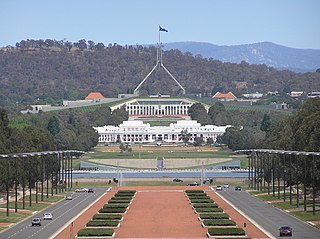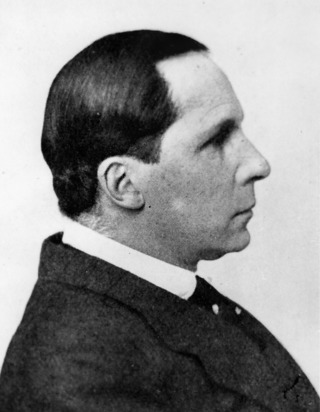
John Smith Murdoch was a Scottish architect who practised in Australia from the 1880s until 1930. Employed by the newly formed Commonwealth Public Works Department in 1904, he rose to become chief architect, from 1919 to 1929, and was responsible for designing many government buildings, most notably the Provisional Parliament House in Canberra, the home of the Parliament of Australia from 1927 to 1988.

John James Clark, an Australian architect, was born in Liverpool, England. Clark's 30 years in public service, in combination with 33 in private practice, produced some of Australia's most notable public buildings, as well as at least one prominent building in New Zealand.

Emil Lawrence Sodersten was an Australian architect active in the second quarter of the 20th century. His work encompassed the Australian architectural styles of Art Deco and Functionalist & Moderne. His design for the Australian War Memorial was "the first national architectural monument in Australia". The Australian Institute of Architects presents the Emil Sodersten Interior Architecture Award annually in his honour.

Robert Smith (Robin) Dods was a New Zealand-born Australian architect.

St Andrew's Uniting Church is a heritage-listed Uniting church at 131 Creek Street, Brisbane CBD, City of Brisbane, Queensland, Australia. It was designed by George David Payne and built in 1905 by Alexander Lind & Son. Initially St Andrew's Presbyterian Church, it became part of the Uniting Church following the merger of the Presbyterian, Methodist and Congregational Churches in 1977. It was added to the Queensland Heritage Register on 21 October 1992.
Charles Tiffin (1833–1873) was an English architect, who spent most of his career in Queensland, Australia where he held the post of Queensland Colonial Architect.
Thomas Pye was an Australian architect. He worked for over 33 years in the Public Works Department in Queensland. Pye contributed significantly to major buildings including the completion of the Public Offices and Rockhampton Customs House, as well as the design for the Lands and Survey Offices. He was responsible for the heightened expectations which produced the best public buildings yet seen in Queensland.

John H. Buckeridge (1857–1934) was an English-born Australian architect, who built about sixty churches in Queensland and is also remembered for remodelling the interior of the Macquarie era church of St James', King Street, Sydney.

George Henry Male Addison (1857–1922) was an Australian architect and artist. Many of his buildings are now heritage-listed.

Conrad Gargett is an Australian architecture and design practice. It was founded in Brisbane in 1890 and is one of Queensland's oldest architectural firms.
Frank Gibson Costello (1903–1987) was an Australian architect. A number of his works are now listed on the Queensland Heritage Register.
Alexander Brown Wilson was an architect in Queensland, Australia. A number of his works are listed on the Queensland Heritage Register.

Karl Langer (1903–1969) was an Austrian-born architect in Queensland, Australia. A number of his works are listed on the Queensland Heritage Register.

John Francis (Jack) Hennessy (1887–1955) was an Australian architect, with the same name as his architect father, John Francis Hennessy, with whom he was in partnership as Hennessy & Hennessy from 1912 to 1924. As principal of the firm after his father retired from 1924 to 1955, he was responsible for many major Art Deco office buildings in capital cities in Australia and New Zealand in the 1930s, as well as many projects for the Catholic Church in Queensland, and the Great Court of the University of Queensland.

Woolloongaba Post Office is a heritage-listed former post office at 765 Stanley Street, Woolloongabba, City of Brisbane, Queensland, Australia. It was designed by Thomas Pye and built in 1905 by Thomas Rees. It is also known as Woolloongabba Post & Telegraph Office. It was added to the Queensland Heritage Register on 24 January 2003.

Benjamin Backhouse was an architect and politician in Australia. He was a Member of the New South Wales Legislative Council.
Claude William Chambers (1861–1947) was a prominent architect in Brisbane, Queensland and Sydney, New South Wales in Australia. Many of his works are listed on the Queensland Heritage Register.

Alfred Barton Brady (1856-1932)was an engineer and architect in Queensland, Australia. He was one of Queensland's most important early engineers and was particularly known for his bridge design. He was the Queensland Colonial Architect and many of his buildings and structures are now heritage-listed.

Townsville Customs House is a heritage-listed former customs house at Wickham Street, Townsville CBD, City of Townsville, Queensland, Australia. It was designed by George David Payne and built from 1900 to 1902 by Crawford & Cameron. It was added to the Queensland Heritage Register on 7 February 2005.
George Bernard Roskell (1850–1926) was an architect in Queensland, Australia. Some of his works are now heritage-listed.















